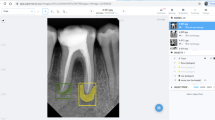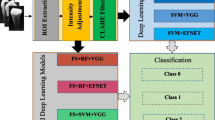Abstract
Orthodontically induced external root resorption (OIERR) is a common complication of orthodontic treatments. Accurate OIERR grading is crucial for clinical intervention. This study aimed to evaluate six deep convolutional neural networks (CNNs) for performing OIERR grading on tooth slices to construct an automatic grading system for OIERR. A total of 2146 tooth slices of different OIERR grades were collected and preprocessed. Six pre-trained CNNs (EfficientNet-B1, EfficientNet-B2, EfficientNet-B3, EfficientNet-B4, EfficientNet-B5, and MobileNet-V3) were trained and validated on the pre-processed images based on four different cross-validation methods. The performances of the CNNs on a test set were evaluated and compared with those of orthodontists. The gradient-weighted class activation mapping (Grad-CAM) technique was used to explore the area of maximum impact on the model decisions in the tooth slices. The six CNN models performed remarkably well in OIERR grading, with a mean accuracy of 0.92, surpassing that of the orthodontists (mean accuracy of 0.82). EfficientNet-B4 trained with fivefold cross-validation emerged as the final OIERR grading system, with a high accuracy of 0.94. Grad-CAM revealed that the apical region had the greatest effect on the OIERR grading system. The six CNNs demonstrated excellent OIERR grading and outperformed orthodontists. The proposed OIERR grading system holds potential as a reliable diagnostic support for orthodontists in clinical practice.








Similar content being viewed by others
Data Availability
The research datasets in this study are not publicly available to protect patient privacy, but are available from the corresponding authors upon reasonable request.
References
Weltman B, Vig KW, Fields HW, Shanker S, Kaizar EE: Root resorption associated with orthodontic tooth movement: a systematic review. Am J Orthod Dentofacial Orthop 137:462-476, 2010.
Sjolien T, Zachrisson BU: Periodontal bone support and tooth length in orthodontically treated and untreated persons. Am J Orthod 64:28-37, 1973.
Andreasen JO: External root resorption: its implication in dental traumatology, paedodontics, periodontics, orthodontics and endodontics. Int Endod J 18:109-118, 1985.
Sondeijker CFW, Lamberts AA, Beckmann SH, Kuitert RB, van Westing K, Persoon S, Kuijpers-Jagtman AM: Development of a clinical practice guideline for orthodontically induced external apical root resorption. Eur J Orthod 42:115-124, 2020.
Li H, Wu X, Huang L, Xu X, Kang N, Han X, Li Y, Zhao N, Jiang L, Xie X, Guo J, Li Z, Mo S, Liu C, Hu J, Shi J, Cao M, Hu W, Cao Y, Song J, Tang X, Bai D: External apical root resorption in orthodontic tooth movement: the risk factors and clinical suggestions from experts’ consensus. Hua Xi Kou Qiang Yi Xue Za Zhi 40:629-637, 2022.
Jiang F, Kula K, Chen J: Estimating the location of the center of resistance of canines. Angle Orthod 86:365-371, 2016.
Thawri SR, Paul P, Reche A, Rathi HP: 3D Technology Used for Precision in Orthodontics. Cureus 15:e47170, 2023.
Liedke GS, da Silveira HE, da Silveira HL, Dutra V, de Figueiredo JA: Influence of voxel size in the diagnostic ability of cone beam tomography to evaluate simulated external root resorption. J Endod 35:233-235, 2009.
Kapila SD, Nervina JM: CBCT in orthodontics: assessment of treatment outcomes and indications for its use. Dentomaxillofac Radiol 44:20140282, 2015.
Al-Falahi B, Hafez AM, Fouda M: Three-dimensional assessment of external apical root resorption after maxillary posterior teeth intrusion with miniscrews in anterior open bite patients. Dental Press J Orthod 23:56-63, 2018.
Celik ME: Deep Learning Based Detection Tool for Impacted Mandibular Third Molar Teeth. Diagnostics 12:942, 2022.
Shen C, Nguyen D, Zhou Z, Jiang SB, Dong B, Jia X: An introduction to deep learning in medical physics: advantages, potential, and challenges. Phys Med Biol 65:05tr01, 2020.
Barragán-Montero A, Javaid U, Valdés G, Nguyen D, Desbordes P, Macq B, Willems S, Vandewinckele L, Holmström M, Löfman F, Michiels S, Souris K, Sterpin E, Lee JA: Artificial intelligence and machine learning for medical imaging: A technology review. Phys Med 83:242-256, 2021.
LeCun Y, Bengio Y, Hinton G: Deep learning. Nature 521:436-444, 2015.
Kim I, Misra D, Rodriguez L, Gill M, Liberton DK, Almpani K, Lee JS, Antani S: Malocclusion Classification on 3D Cone-Beam CT Craniofacial Images Using Multi-Channel Deep Learning Models. Annu Int Conf IEEE Eng Med Biol Soc 2020:1294-1298, 2020.
Lee DW, Kim SY, Jeong SN, Lee JH: Artificial Intelligence in Fractured Dental Implant Detection and Classification: Evaluation Using Dataset from Two Dental Hospitals. Diagnostics 11:233, 2021.
Li CW, Lin SY, Chou HS, Chen TY, Chen YA, Liu SY, Liu YL, Chen CA, Huang YC, Chen SL, Mao YC, Abu PAR, Chiang WY, Lo WS: Detection of Dental Apical Lesions Using CNNs on Periapical Radiograph. Sensors 21:7049, 2021.
Lian L, Zhu T, Zhu F, Zhu H: Deep Learning for Caries Detection and Classification. Diagnostics 11:1672, 2021.
Alotaibi G, Awawdeh M, Farook FF, Aljohani M, Aldhafiri RM, Aldhoayan M: Artificial intelligence (AI) diagnostic tools: utilizing a convolutional neural network (CNN) to assess periodontal bone level radiographically-a retrospective study. BMC Oral Health 22:399, 2022.
Wang B, Shen G, Fang B, Zhang L: Crown-root morphology of lower incisors in patients with class III malocclusion. J Craniofac Surg 23:e349-354, 2012.
Wang B, Shen G, Fang B, Yu H, Wu Y: Augmented corticotomy-assisted presurgical orthodontics of class III malocclusions: a cephalometric and cone-beam computed tomography study. J Craniofac Surg 24:1886-1890, 2013.
Levander E, Malmgren O: Evaluation of the risk of root resorption during orthodontic treatment: a study of upper incisors. Eur J Orthod 10:30-38, 1988.
Fawcett T: An introduction to ROC analysis. Pattern Recognit Lett 27:861-874, 2005.
Seo H, Hwang J, Jeong T, Shin J: Comparison of Deep Learning Models for Cervical Vertebral Maturation Stage Classification on Lateral Cephalometric Radiographs. J Clin Med 10:3591, 2021.
Chen IDS, Yang CM, Chen MJ, Chen MC, Weng RM, Yeh CH: Deep Learning-Based Recognition of Periodontitis and Dental Caries in Dental X-ray Images. Bioengineering 10:911, 2023.
Gouda W, Sama NU, Al-Waakid G, Humayun M, Jhanjhi NZ: Detection of Skin Cancer Based on Skin Lesion Images Using Deep Learning. Healthcare 10:1183, 2022.
Ananthakrishnan B, Shaik A, Kumar S, Narendran SO, Mattu K, Kavitha MS: Automated Detection and Classification of Oral Squamous Cell Carcinoma Using Deep Neural Networks. Diagnostics 13:918, 2023.
Arun Prakash J, Asswin CR, Ravi V, Sowmya V, Soman KP: Pediatric pneumonia diagnosis using stacked ensemble learning on multi-model deep CNN architectures. Multimed Tools Appl 82:21311-21351, 2023.
Howard A, Sandler M, Chen B, Wang W, Chen LC, Tan M, Chu G, Vasudevan V, Zhu Y, Pang R, Adam H, Le Q: Searching for MobileNetV3. In: 2019 IEEE/CVF International Conference on Computer Vision (ICCV), 2019, pp 1314–1324.
Tan M, Le QV: EfficientNet: Rethinking Model Scaling for Convolutional Neural Networks. In: the 36th International Conference on Machine Learning, 2019, pp 6105–6114.
Yu Q, Ning Y, Wang A, Li S, Gu J, Li Q, Chen X, Lv F, Zhang X, Yue Q, Peng J: Deep learning-assisted diagnosis of benign and malignant parotid tumors based on contrast-enhanced CT: a multicenter study. Eur Radiol 33:6054-6065, 2023.
Refaeilzadeh P, Tang L, Liu H: Cross-Validation, Boston, MA: Springer, 2009
Yadav S, Shukla S: Analysis of k-Fold Cross-Validation over Hold-Out Validation on Colossal Datasets for Quality Classification. In: 2016 IEEE 6th International Conference on Advanced Computing (IACC), 2016, pp 78–83.
Dogra A, Bhalla P: Image Sharpening By Gaussian And Butterworth High Pass Filter. Biomed Pharmacol J 7:707-713, 2014.
Mao YC, Huang YC, Chen TY, Li KC, Lin YJ, Liu YL, Yan HR, Yang YJ, Chen CA, Chen SL, Li CW, Chan ML, Chuo Y, Abu PAR: Deep Learning for Dental Diagnosis: A Novel Approach to Furcation Involvement Detection on Periapical Radiographs. Bioengineering 10:802, 2023.
Selvaraju RR, Cogswell M, Das A, Vedantam R, Parikh D, Batra D: Grad-CAM: Visual Explanations from Deep Networks via Gradient-Based Localization. In: 2017 IEEE International Conference on Computer Vision (ICCV), 2017, pp 618–626.
Lee KS, Kwak HJ, Oh JM, Jha N, Kim YJ, Kim W, Baik UB, Ryu JJ: Automated Detection of TMJ Osteoarthritis Based on Artificial Intelligence. J Dent Res 99:1363-1367, 2020.
Yu HJ, Cho SR, Kim MJ, Kim WH, Kim JW, Choi J: Automated Skeletal Classification with Lateral Cephalometry Based on Artificial Intelligence. J Dent Res 99:249-256, 2020.
Zhang JN, Lu HP, Hou J, Wang Q, Yu FY, Zhong C, Huang CY, Chen S: Deep learning-based prediction of mandibular growth trend in children with anterior crossbite using cephalometric radiographs. BMC Oral Health 23:28, 2023.
Funding
This study was funded in part by Chongqing Municipal Health Commission Program (2020GDRC002), Program for Youth Innovation in Future Medicine of Chongqing Medical University (W0055), Chongqing Young and Middle-aged Medical High-end Talent Studio, Young Clinical Research Fund of the Chinese Stomatological Association (CSA-O2022-07), Scientific and Technological Innovation Project of Construction of Double City Economic Circle in Chengdu-Chongqing Area of Chongqing Education Commission (KJCX2020017), and Open project of the Shanxi Provincial Key Laboratory for Prevention and Treatment of Oral Diseases and New Materials (KF2020-01).
Author information
Authors and Affiliations
Contributions
Study design, SXX, HLP, LXY, WJZ, XG, and JLS; data acquisition, SXX; data analysis, SXX, HLP, and LXY; clinical studies, SXX, HLP, and LXY; manuscript writing, SXX, HLP, and LXY; manuscript editing, SXX, HLP, LXY, WJZ, XG, and JLS. All authors have given approval to the final version of the manuscript.
Corresponding authors
Ethics declarations
Ethics Approval
This study was in accordance with the Declaration of Helsinki and was approved by the Ethics Committee of the Affiliated Stomatological Hospital of Chongqing Medical University (CQHS-REC-2023 (LSNo. 039)). The informed consent was waived in view of the retrospective nature and low risk involved of this study.
Competing Interests
The authors declare no competing interests.
Additional information
Publisher's Note
Springer Nature remains neutral with regard to jurisdictional claims in published maps and institutional affiliations.
Supplementary Information
Below is the link to the electronic supplementary material.
Rights and permissions
Springer Nature or its licensor (e.g. a society or other partner) holds exclusive rights to this article under a publishing agreement with the author(s) or other rightsholder(s); author self-archiving of the accepted manuscript version of this article is solely governed by the terms of such publishing agreement and applicable law.
About this article
Cite this article
Xu, S., Peng, H., Yang, L. et al. An Automatic Grading System for Orthodontically Induced External Root Resorption Based on Deep Convolutional Neural Network. J Digit Imaging. Inform. med. (2024). https://doi.org/10.1007/s10278-024-01045-6
Received:
Revised:
Accepted:
Published:
DOI: https://doi.org/10.1007/s10278-024-01045-6




